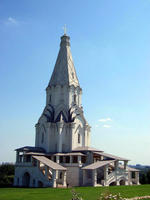You are in: Europe -> Russia -> Church of the Ascens... , and traditional search or Image Gallery will yield results of this site only
Church of the Ascension, Kolomenskoye
| Site number: | 634 |
|
| Type of site: | Cultural | |
| Date: | 1532 | |
| Date of Inscription: | 1994 | |
| Location: | Eurasia, Russian Federation, Moscow, the South District | |
Up to 75 images are shown here. Click on each for more details or on Image Gallery for more images.
| Description: | The Church of the Ascension was constructed near Moscow, on the imperial estate of Kolomenskoye, in 1532, to commemorate the birth of a prince, soon to become Tsar Ivan IV ('the Terrible'). Being among the first cases of a traditional wooden tent-roofed church built upon a stone and brick substructure, it held a great influence on the development of Russian ecclesiastical architecture. --WHMNet paraphrase from the description at WHC Site, where additional information is available. | |
| Kolomenskoe village was first mentioned in the testament of Ivan Kalita (1339). As the time went by, the village was developed as a favourite country estate of grand princes of Muscovy. The earliest extant structure is the exceptional Ascension church (1532), built in white stone to commemorate the long-awaited birth of an heir to the throne, the future Ivan the Terrible. Being the first stone church of tent-like variety, the uncanonical "White Column" (as it is sometimes referred to) marked a stunning rupture with the Byzantine tradition. The church stands up toward the sky from a low cross-shaped podklet (ground floor), then follows a prolonged chetverik (octagonal body) of the church, and then an octagonal tent, crowned by a tiny dome. The narrow pilasters on the sides of the chetverik, the arrow-shaped window frames, the three tiers of the kokoshniks and the quiet rhythm of stair arcades and open galleries underline the dynamic tendency of this masterpiece of the Russian architecture. The whole vertical composition is believed to have been borrowed from hipped roof-style wooden churches of the Russian North. Recognizing its outstanding value for humanity, UNESCO decided to inscribe the church on the World Heritage List in 1994. --Wikipedia. Text is available under the Creative Commons Attribution-ShareAlike License. | ||
| Source: | http://whc.unesco.org/en/list/634 | |
| Reference: | 1. UNESCO World Heritage Center, Site Page. | |


